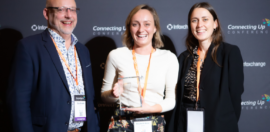Vic Govt Funds Ground-Breaking Homelessness Project
2 March 2016 at 12:01 am
The Victorian Government has allocated $1.2 million for a targeted program to end long-term homelessness that has been piloted by welfare Not for Profit, Sacred Heart Mission.
Minister for Housing, Disability, Ageing and Mental Health, Martin Foley is to outline the funding deal worth $1.2 million over three years on Wednesday for the second stage of the Sacred Heart Mission’s Journey to Social Inclusion Program (J2SI).
The Victorian Government is contributing a third of the overall $3.69 million cost of the three year program.
Sacred Heart Mission said it is investing the remainder of the funding with a portion coming from philanthropy.
“The J2SI pilot that ran from 2009-2012 delivered impressive results demonstrating that by taking a different approach to what is currently available, the cycle of long-term homelessness can be broken,” J2SI Manager Anna Paris said.
“A study undertaken a year post the culmination of the three year study showed 75 per cent of participants remained in stable housing after four years, 80 percent had seen a decline in the need for health services and the study offered savings to government of up to $32,080 per participant.
“Based on findings from the pilot, the program is being refined, and expanded from 40 to 60 participants and geographically beyond St Kilda to include Melbourne’s inner-north through partnerships with St Mary’s House of Welcome and Vincent Care’s Ozanam Community Centre.”
The Centre for Social Impact at the University of Western Australia is conducting the impact and economic evaluations so that the Not for Profit can benchmark its outcomes for J2SI participants against a group using existing services.
Sacred Heart Mission said recruitment of participants for the second phase is currently underway.
Anna Paris said the organisation had recruited almost half of the total participants to date and that while the participants’ pathways into homelessness were diverse, there are common themes.
“Some have entered homelessness as youths after early childhood trauma and/or family breakdown, which has then led to chronic homelessness. Others have lived full lives, with employment and families, but multiple crises such as emerging mental illness and loss of employment, combined with a lack of affordable housing, has led to them becoming homeless in adulthood,” she said.
“Amongst the group, there is a high prevalence of major mental illness, poly-drug use, and people aged over 45 which demonstrates a need to test effective homelessness interventions for our growing ageing population.
“The participants are resilient, survivors, and have hopes and dreams for their lives. But also for some, they are distrusting that their hopes and dreams can be achieved as they have been let down repeatedly and been through multiple cycles of homelessness, whether over a few years, decades, or a lifetime.”
The CEO of Sacred Heart Mission, Cathy Humphrey said the organisation was pleased to have the backing of the Victorian Government.
“Journey to Social Inclusion is setting a new benchmark for addressing long-term homelessness in Australia,” Humphrey said.
“The pilot of Sacred Heart Mission’s ground-breaking service model, Journey to Social Inclusion has proven that people with complex needs can live stable, fulfilling lives and be part of society.
“It is different, as it takes a relationship-based approach, provides long-term support, and works from the premise that if people can sustain their housing and manage their complex health issues, this provides a solid foundation to the next steps of building skills, becoming a part of the community and contributing to society.
“Ultimately J2SI saves lives, reduces reliance on the service system including expensive health and emergency services, and prevents people from being incarcerated.”
J2SI Intensive Case Manager Rob Telfer was part of the pilot and has returned for this second phase.
“With regular case management you get to work with someone for 13 weeks. If you get lucky, you may secure housing for the person but you run out of time to support them to maintain their housing. This is vital if someone has been sleeping rough for years and has never really cooked or paid bills. If they fall out of housing, you’re not around to support them back in,” Telfer said.
“Through the J2SI pilot, I worked with a gentleman who had been homeless for 30 years and was always placed in housing that would fall down due to being unsuitable for his needs. As we had the time to work together and build a relationship, I was able to advocate on his behalf and through ongoing negotiations with a housing provider, secure long-term accommodation in a safer environment. He still lives there today.”
Cathy Humphrey said that the second stage is key to demonstrating the scalability and replicability of J2SI with a view to rolling out the program in areas of high, chronic homelessness in Australia through a licensing arrangement with other agencies.
“It’s estimated there are 22,000 Australians who are long-term homeless so J2SI is an opportunity to make a meaningful reduction,” she said.








As Manager of The Beacon in Perth we can identify with this article J2SI, we too have findings such as indicated through your article and longer time frame to work with the clients most definitely leads to better outcomes. We have combined S2H with our Accommodation facility which has led to 80% of clients through our facility gaining long term, affordable and sustainable housing. We run a case management and therapeutic model which works well. The success is clients who want to change their circumstances, building relationships constantly and engaging with those who are still pre-contemplative. Great read…